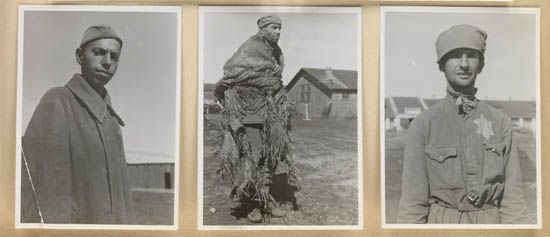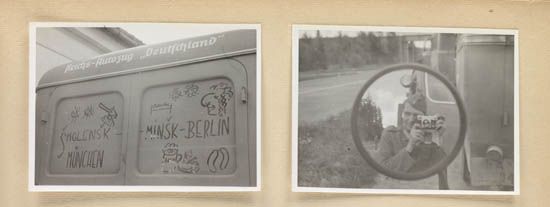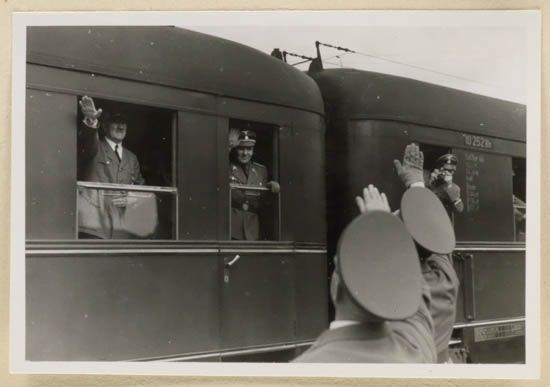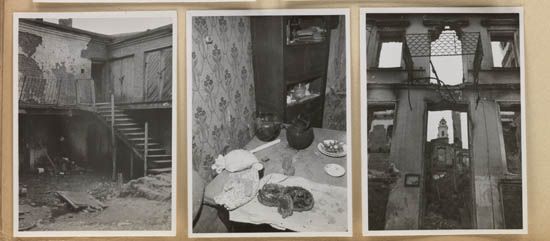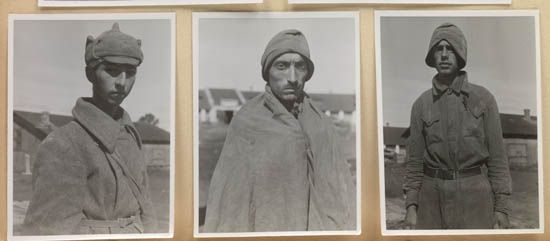Sale 2257 - Lot 134
Unsold
Estimate: $ 25,000 - $ 35,000
(WORLD WAR II)
An uncommon Nazi album containing 214 photographs of military activities in Germany and the Soviet Union, in addition to images of the photographer's personal life. The photographs were largely shot and, apparently, sequenced and compiled by Franz Krieger, an Austrian-national soldier. Krieger joined, and then quit, a Wehrmacht propaganda unit known as the Propagandakompanie (a.k.a. "Reichs Autozug Deutschland" [Reichs Automobile Platoon]). With compelling images of Jewish and Red Army political prisoners in Minsk, the Jewish ghetto, Hitler meeting Adm. Horthy in Marienburg, in addition to scenes of Nazi soldiers at the Eastern Front, self-portraits (including a few of Krieger recovering in a hospital), motorcycle demonstrations, and snapshots of the photographer and his paramour on holiday. Silver prints, 2 3/4x4 inches (7x10.2 cm.), 4 to 5 tipped to a page. Oblong 4to, green leatherette; ties; condition of the prints is generally excellent. 1941-1942
An uncommon Nazi album containing 214 photographs of military activities in Germany and the Soviet Union, in addition to images of the photographer's personal life. The photographs were largely shot and, apparently, sequenced and compiled by Franz Krieger, an Austrian-national soldier. Krieger joined, and then quit, a Wehrmacht propaganda unit known as the Propagandakompanie (a.k.a. "Reichs Autozug Deutschland" [Reichs Automobile Platoon]). With compelling images of Jewish and Red Army political prisoners in Minsk, the Jewish ghetto, Hitler meeting Adm. Horthy in Marienburg, in addition to scenes of Nazi soldiers at the Eastern Front, self-portraits (including a few of Krieger recovering in a hospital), motorcycle demonstrations, and snapshots of the photographer and his paramour on holiday. Silver prints, 2 3/4x4 inches (7x10.2 cm.), 4 to 5 tipped to a page. Oblong 4to, green leatherette; ties; condition of the prints is generally excellent. 1941-1942
Additional Details
A mystery album whose contents lay fallow until James Barron and David W. Dunlap, journalists with The New York Times, posted an article, which appeared on the Times's blog, Lens (June 25, 2011), featuring a handful of representative images. Given the album's broad range of pictures -- Nazi solders en route to Minsk (the site of a concentration camp), political prisoners of war, a Jewish prisoner wearing a Star of David, Hitler arriving at Marienurg, as well as scenes of the photographer and his "frau" (a Marlene Dietrich-lookalike) -- the story was immediately picked up by Eines Tages [Someday], a site associated with the German magazine Der Spiegel, whose blog received more than 7 million hits in a single day!
An online reader in Germany quickly identified the pictures as the work of Franz Krieger (1914-1993), a former Austrian press photographer and businessman. Readers in South Africa, the U.S. and Europe posted additional information, clarifying the location or backstory to some of the pictures. Clearly the photographs still had extraordinary resonance and historical interest. Perhaps this overwhelming response may be attributed to Krieger's direct, if not artful, documentary style as well his special access to Hitler. Indeed, the album's narrative reflects a startling duality, alternating between pictures of the photographer's personal life and the military activities he was commissioned to document. The pictures offer glimpses into the quotidian nature of the soldiers' lives, which is counterpointed with compelling portraits depicting the victims of the Nazi's brutal campaign.
An online reader in Germany quickly identified the pictures as the work of Franz Krieger (1914-1993), a former Austrian press photographer and businessman. Readers in South Africa, the U.S. and Europe posted additional information, clarifying the location or backstory to some of the pictures. Clearly the photographs still had extraordinary resonance and historical interest. Perhaps this overwhelming response may be attributed to Krieger's direct, if not artful, documentary style as well his special access to Hitler. Indeed, the album's narrative reflects a startling duality, alternating between pictures of the photographer's personal life and the military activities he was commissioned to document. The pictures offer glimpses into the quotidian nature of the soldiers' lives, which is counterpointed with compelling portraits depicting the victims of the Nazi's brutal campaign.
Exhibition Hours
Exhibition Hours
Aliquam vulputate ornare congue. Vestibulum maximus, libero in placerat faucibus, risus nisl molestie massa, ut maximus metus lectus vel lorem.




